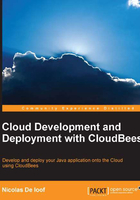
CloudBees – embrace the development stack
CloudBees PaaS has something special in its DNA that you won't find in other PaaS; focusing on the Java ecosystem first, even with polyglot support, CloudBees understands well the Java ecosystem's complexity and its underlying practices.
Heroku was one of the first successful PaaS, focusing on Ruby runtime. Deployment of a Ruby application is just about sending source code to the platform using the following command:
git push heroku master
Ruby is a pleasant ecosystem because there are no such long debates on building and provisioning tools that we know of, unlike in JavaWorld, GemFile, and Rake, period.
In the Java ecosystem, there is a need to generate, compile the source code, and then sometime post the process classes, hence a large set of build tools are required. There's also a need to provision runtime with dozens of dependencies, so a set of dependency management tools, inter-project relations, and so on are required. With Agile development practices, automated testing has introduced a huge set of test frameworks that developers want to integrate into the deployment process.
The Java platform is not just about hosting a JVM or a servlet container, it's about managing Ant, Maven, SBT, or Gradle builds, as well as Grails-, Play-, Clojure-, and Scala-specific tooling. It's about hosting dependency repositories. It's about handling complex build processes to include multiple levels of testing and code analysis.
The CloudBees platform has two major components:
- RUN@cloud is a PaaS, as described earlier, to host applications and provide high-level runtime services
- DEV@cloud is a continuous integration and deployment SaaS based on Jenkins
Jenkins is not the subject of this book, but it is the de facto standard for but not limited to continuous integration in the Java ecosystem. With a large set of plugins, it can be extended to support a large set of tools, processes, and views about your project.
The CloudBees team includes major Jenkins committers (including myself #selfpromotion), and so it has a deep knowledge on Jenkins ecosystem and is best placed to offer it as a Cloud service. We also can help you to diagnose your project workflow by applying the best continuous integration and deployment practices. This also helps you to get more efficient and focused results on your actual business development.
The following screenshot displays the continuous Cloud delivery concept in CloudBees:

With some CloudBees-specific plugins to help, DEV@cloud Jenkins creates a smooth code-build-deploy pipeline, comparable to Heroku's Git push, but with full control over the intermediary process to convert your source code to a runnable application. This is such a significant component to build a full stack for Java developers that CloudBees is the official provider for the continuous integration service for Google App Engine (http://googleappengine.blogspot.fr/2012/10/jenkins-meet-google-app-engine.html), Cloud Foundry (http://blog.cloudfoundry.com/2013/02/28/continuous-integration-to-cloud-foundry-com-using-jenkins-in-the-cloud/), and Amazon Beanstalk (to be announced as I'm writing this chapter).